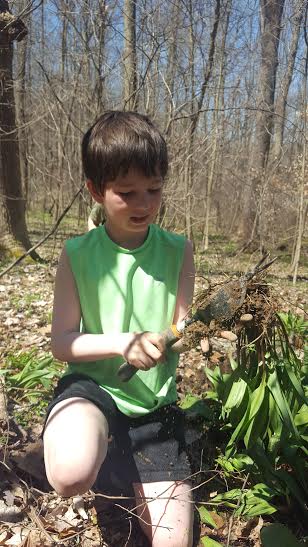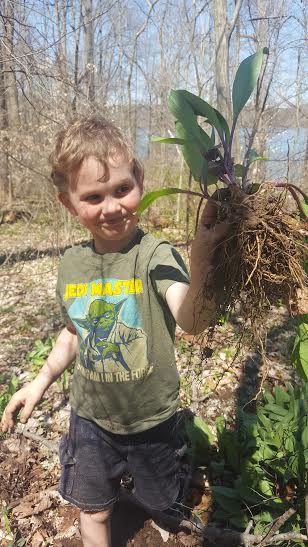It’s spring in West Virginia again. That’s a good thing, because the temperature allows me to write this outside. The grass is a soft, green carpet beneath my feet. Mason bees buzz around my stone foundation and the air has turned humid and sweet with birdsong. It’s been a dark winter, one that bound me in long underwear and alpaca socks during endless afternoons of freezing drizzle when my patience for the coming of spring wore miserably thin. Now, the green and blue have come back to West Virginia, and I’m out in it.
Of course, I’m not actually outside to breathe this welcome vernal breeze. I’m out here because I stink.
In fact, my entire family reeks to high heaven. We’ve all scattered to separate corners of the property to get away from each other because we’re so pungent that we can’t tell where one of us ends and another begins. But it’s not for lack of hygiene; we Roberts are quite the shower-loving bunch. This is a funk of neither foot nor sweat.
It’s the odor of ramps, a bulb-forming perennial that appears in April. I’ve just eaten several. An odd little plant, it’s kind of an onion, kind of a leek. Similar to a shallot. Not so different from a scallion. Reminiscent of garlic. And yet, the ramp is its own beast. People call it the King of Stink. The ramson. West Virginia Funky Gold. (I made that last one up myself.) Ramps drive people crazy when they appear at a farmer’s market, where they may sell for twenty dollars per pound. We’re talking Saturday morning stampedes, if the reports are to be believed. Famous chefs blog about them, cook with them, rave about them. They’ve caught on as an en vogue vegetable, hence the prices. Ramp season is short, limited to a few weeks in the spring, adding to their mystique.

I smell because I’ve just eaten what’s referred to as a “mess of ramps,” and I’m going to go out on a limb and say that’s probably a technical term, like a clowder of cats or a bellowing of bullfinches. The little stinkers grow in moist, shady places in the woods, and while we West Virginians take special pride in their presence, you can actually find them throughout eastern hardwood forests from Georgia to Canada.
Every spring, the arrival of the ramps is heralded in the mountain state by festival goers. Richwood, West Virginia holds what it calls the king of all ramp festivals, The Feast of the Ramson, and they claim that their particular feast is the original West Virginia ramp celebration. In fact, spring ramp dinners take place all over the state, in fire halls and church basements, and I strongly suspect that church lady ramp dishes can give New York City chefs a run for their money.
Ramps are funky little buggers. When I open the fridge after a fresh harvest, their scent bursts forth and slaps me in the face. And yet, the flavor of the ramp isn’t overpowering. While it’s intense like garlic, it’s also sweet like a leek. The ramp works well as an accent, a tone flavor. Having just finished a degree in creative writing, I should be able to tell you how they taste, but I’m afraid a precise description escapes me. Ramps are like the promise of summer and the smell of the West Virginia earth wrapped into a salty, peppery, holy-crap-that-was-delicious mouthful of joy. That’s the best I’ve got.

The ramp can be as complicated or as simple as you like. I’m a decent chef but not one who enjoys a complex meal preparation. Though I can handle four or five ingredients, by the time I get to the part about shaving a lemon rind or deglazing a pan, I’m standing line at DiCarlo’s. But that’s okay. If you’re a five-ingredient chef like me, the ramp can work with you. The ramp is forgiving. The ramp is flexible.
The first time we cooked ramps, we diced them and threw them in with potatoes. The next time, we tossed them into a garden salad—just a couple in place of onions, to accent the greens. Last weekend, we cleaned them, brushed them with extra virgin olive oil, salt-and-peppered them, and threw them on the grill for 90 seconds until they blackened and wilted. And finally, as I write this, the smell of ramp-burgers clings to me like a splendid, pungent cloud. I realize I’m not making the ramp sound particularly sexy. You wouldn’t eat a ramp-burger on, say, Valentine’s Day, or before church. Maybe before a job interview, you should stick to pasta. The ramp certainly isn’t for everybody, but the flavor of the ramp-burger my husband grilled tonight far outweighs the millstone of humiliation. Ramps are particularly good with fatty foods. You’re just going to have to trust me on this. Google ramp recipes. They are myriad.
You’d think with the way I’ve talked up the ramp and its glorious stinkiness that all would be well in the world. But, as with everything, there’s a catch to all of this rampy goodness. Yes, spring is a leeky wonderland in West Virginia. On the hillside where we dig our ramps (no, I wouldn’t trade its location for all the sweat socks in the world), they grow by the thousands. Ramps as far as the eye can see. But in other parts of the east, the ramp has become harder to find. Diehard rampers must forage deeper and deeper into the forest. Quebec has designated the ramp a threatened species. Great Smokey Mountain National Park has outlawed the harvesting of the spring leek, so picked over have they become in places.
In fact, I hesitated to write this piece because I am so concerned that the blessed leek will succumb to overharvesting by greedy pickers. Seeds take 6 to 18 months to germinate, and plants take 5 to 7 years to produce seeds. They’re not the speediest of growers, so rampers need to understand how to sustainably forage. After all, humans aren’t always so good at restraint.

Every April, my husband and I take the kids to our secret ramp spot. We dig enough for four or five meals, and we dig a few to transplant into our yard at home, where we happen to have a small creek along which they happily grow in the shade. The home patch isn’t for harvesting, yet. Perhaps in ten years, if they continue to thrive, we’ll be able to pick a few. We tell our boys that West Virginians love nature and take pride in our ramps and that we need to make sure there are enough of them in the forest to repopulate what we take. I’m not sure if the lads even like ramps yet, but the lesson is an important one: nature will always share, so take a little and leave the rest.
I’d planned on attending a lecture this evening. Now, as I sit with myself, I realize I’d only be torturing those around me if I went. I reek of leek. Fortunately, I’m in good company. The best way to enjoy ramps is with your loved ones.
Happy sustainable ramping!




